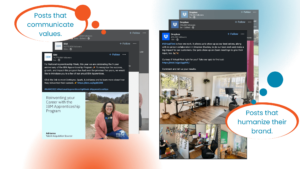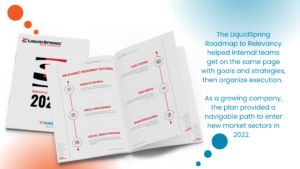The best part of #AgencyLife, for us, is the opportunity to cultivate collaborative relationships with our clients, especially when it comes to setting strategy and projecting budgets. Right now, this is Prime Time for doing both – looking forward to next year’s goals and steering budgets to accommodate the plans and tactics that will help us reach those goals.
Annual marketing plans are imperative to:
- align organizational goals,
- optimize resource allocation, and
- drive targeted efforts that ultimately propel business growth and sustain a competitive edge in the market.
While no single strategy fits every business, there are some standard practices that will make crafting your 2024 marketing plan as easy as it can be. Let’s cruise through them, starting with what you as a marketing team already know.
Questions to Consider When Developing Your Marketing Plan
How much did your company grow last year?
Take a look at the big-picture numbers. If growth was in the cards, would you be satisfied with similar growth for this coming year? If it is realistic to set sights on the same growth, ask yourself how much of your plan needs to change to remain relevant. Odds are, you can continue with what works – and shift away from what performed poorly, or below expectations. If you want to grow even more, give that goal a firm number that your team can rally around. A clear goal for this time next year will help guide the rest of your planning.
What marketing channels produced results?
Pull out your plan and strategies from last year (or, ahem, emails and receipts) and take a look at what actually worked. Did consistent, well-written ads drive traffic? Did consistent and targeted email messaging drive engagement? What about collateral? Any calls from it? While you may have a gut feel for some of these, it’s important to analyze key performance indicators when crafting—and allocating money to—your next marketing strategies.
Also, please note the use of the word consistent above. It’s the key to continued growth.
Based on this information, the channels that produced results are the ones where you’ll want to spend time and money. It means your audience is already there, and receptive to your brand’s message.
What messages were well-received?
Did your how-to posts get the most eyeballs? Or your long-content blogs? Or was it short & sweet sales copy that seemed to resonate best with your audience? Analyze your web traffic, conversions, and even sales related to each campaign to understand how your audience likes to be spoken to.
What’s happening in your industry?
What big picture trends shifted in your industry this year? What are people talking about? What changes do you see on the horizon? And what are your competitors doing? If they succeeding in areas where you aren’t, can you find out why? And do you see any new differentiators between you and your competitors?
Taking a look around gets you out of your silo. Talk to others within your industry if possible. Or search for marketing agencies that specialize in your industry—it’s their job to talk about trends and they’re often brimming with industry research and insights.
What did you learn from your customers this year?
Start with feedback that’s immediately accessible to your department. What reviews came through? Take a look at social comments and messages, as well as replies to marketing communications. If customer surveys are a part of your workflow, analyze that data on an annual basis. Make a list of common statements/customer takeaways, as well as customer issues and complaints. These will turn into value propositions and issues to address down the road.
Now, Talk to Someone Else in Your Company
With your marketing team insights in hand, it’s time to talk to sales, product development, testing, etc. Ask them what they think is most important for your customers to know in the coming year. Ask them what is most important to them. Ask them what it’s like to work for the company, or why they do. There are stories everywhere, and value propositions can be uncovered if you just listen.
Take what you learn from your internal teams and consider how you might turn that into a benefit statement for your audience. Those benefit statements can become taglines, campaigns, and copy for any collateral. Once you start building your annual strategy, the pieces will fall into place and you’ll see where and how you can use them.
These questions and conversations serve as a type of pulse check on your brand, discovering where you stand on the audience’s relevance meter. Hopefully, you remain high in demand, but if you find yourself lagging behind, there are plenty of ways to boost your brand’s relevance – including recharging your marketing.
Take a Look at Your Expenses
While it’s fun to spend money (we’re marketers!), it’s even more rewarding to see it work. So take a look at your expenses and check them against your KPIs. What actually worked for you? Can you find a clear correlation between social spend and website traffic? Or your Performance Max campaigns and conversions? Were your leads from the trade show valid; how many turned into sales?
You can also look at working hours as a spend. Did your team’s time creating content boost your SEO/web traffic? Was the amount of time spent on email creation worth the conversion statistic?
Questions like these will help you understand where your most valuable spending was this year, and where you want it to invest in the future.
A few thoughts from our team
Not all things that shimmer are gold. Don’t let a beautiful presentation fool you when it comes to your marketing spend. Go deep in your cost analysis and compare your goals against your results so that you can allocate your budget with informed intent. Based on what we’ve seen working in the past year, here are a few strategies to consider when creating your 2024 marketing plan:
Invest in Paid Media & SEO for customer acquisition
When it comes to getting digital feet in the door, Paid Media and SEO still reign supreme for our B2B manufacturing clients. Here’s how they should work in harmony: Paid Media gets people to your site while you build your organic visibility and search reputation. Creating consistent, high-quality content for your website will result in longer-lasting and better-performing traffic. While Paid Media booms, it can also bust your budget if you’re not paying attention. So do both, but watch your cost per acquisition/conversion to understand how long it is a valid tool for your growth goals.
Invest in social to boost brand value
If your audience is social, consider investing in content creation as well as community management. Just as you do for your site, take the time to develop informative and entertaining content (though very short-form, of course) that will help your target move down the funnel toward a purchasing decision. Investing manpower or time into responding to your community can result in incredible gains: from brand perception to conversion.
Companies such as IBM and Dropbox do great jobs at showcasing their capabilities, humanizing their brand, and communicating their values.

When it comes to knowing where to post, we always recommend testing. Spend 2-4 weeks consistently posting content and moderating comments to get a feel for where engagement is highest. And don’t forget LinkedIn. It’s not just for person-to-person contact. Over 40% of the platform’s 760 million users are active on a daily basis. Further, 65 million of those users are B2B decision makers.
Invest in video if you’re looking for brand awareness
Video has the power to tell a story in a way that no other medium can. It can be used in every communications channel and can be edited for extended life. Video is consistently proving itself valuable when it comes to mindshare. TV, social, YouTube, and other online video ads help customers easily recall your brand when they need. How often have you been able to recall a brand name because you remember the commercial, or the persona from the commercial? (Here’s lookin’ at you, every insurance company ever).
Invest in email
Email marketing serves as a direct and personalized channel to engage with a targeted audience. It allows businesses to tailor their messages and content, delivering them right to the inbox of potential customers. Through email campaigns, businesses can nurture leads, enhance brand loyalty, and drive conversions by strategically sending out information, promotions, updates, and personalized offers. Moreover, email marketing is highly cost-effective and offers an exceptional return on investment (ROI). Additionally, email marketing provides valuable analytics and insights, enabling companies to refine their strategies based on recipient engagement and behavior, ensuring continuous improvement and effectiveness.
Solid Marketing Strategy Should Always Tie to Business Objectives
So what are your 2023 marketing objectives? Is it to increase site traffic by 25%? Or increase qualified leads by 30% in Q1? Starting with your objectives is key to successful strategic planning and tactical execution.
If you find yourself unsure of where to start, our Relevancy Roadmap process can help you outline realistic objectives based on past performance, brand health, and current trends.
Our roadmaps are customized to help each business we work with uncover practical objectives, then develop and launch strategies at the right time and in the right order. With one to two key performance indicators detailed for each strategy, you can
1. Discover the true cost of each goal completion, and
2. move forward with your marketing plan with confidence and agility.
As you sit down to begin your annual strategy, remember that you can always start with what you know works, and build as you continue to learn and grow. If you know two things are working well, keep them going. And if you know you only have time for one campaign per quarter, plan for that. Don’t overwhelm your plan with unrealistic expectations, as rewarding as they may feel while you write them. And most importantly, have a little fun. This is your chance to show your successes from last year, get creative with new campaigns, and build a 2024 marketing plan you’re excited to implement.

